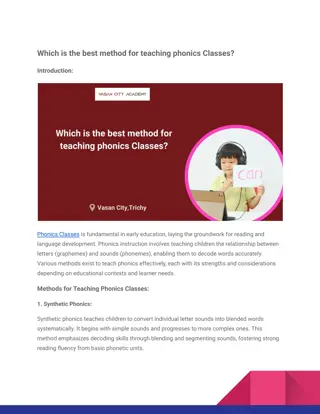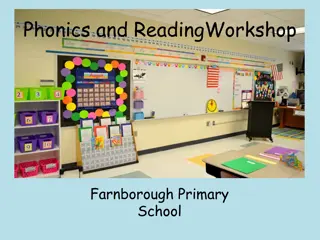Learning Phonics and Vocabulary in Early Education
Breaking down words into sounds, understanding phonemes, CVC words, mnemonic techniques, tricky words, segmenting, blending, digraphs, and consolidating learning through the 6 phases of Letters and Sounds in early education to develop foundational language skills.
Download Presentation

Please find below an Image/Link to download the presentation.
The content on the website is provided AS IS for your information and personal use only. It may not be sold, licensed, or shared on other websites without obtaining consent from the author.If you encounter any issues during the download, it is possible that the publisher has removed the file from their server.
You are allowed to download the files provided on this website for personal or commercial use, subject to the condition that they are used lawfully. All files are the property of their respective owners.
The content on the website is provided AS IS for your information and personal use only. It may not be sold, licensed, or shared on other websites without obtaining consent from the author.
E N D
Presentation Transcript
SOUND TALKING Breaking a word down into its component sounds, this is often done orally and using fingers as an aid PHONEME A single unit of sound CVC WORD A word made up of a consonant phoneme, then a vowel phoneme then another consonant phoneme F i-sh (Fish) C-a-t (cat) Sh ee p (sheep) Phase 1 key vocabulary
Phase 2 key vocabulary MNEMONIC An action to support a sound GRAPHEME the mark on the page that represents a letter sound like graphic TRICKY WORDS Words that do not make phonological sense SEGMENTING A child may want to write the word cat so they have to think of each sound in the word individually BLENDING Children will see the word cat and say each component sound to read the word GRAPHEME / PHONEME CORRESPONDENCE when a child is able to see the mark on the page and say the correct sound
6 phases of Letters and Sounds Phase 3 Children are introduced to letter names Taught another 25 letter sounds most of which comprise of two letter digraphs SET 6 j, v, w, x SET 7 y, z, zz, qu Consonant digraphs ch, sh, th, ng Vowel digraphs ee, oo, ai, oa, ar, ow, oi, igh, air, ear, er, ur, ure
SOUND BUTTONS & DIGRAPH LINES This is the mark adults put under letters to support children to say the sounds Phase 3 key vocabulary DIGRAPH 2 letters that make 1 sound CONSONANT DIGRAPH at least one of the letters in the digraph is a vowel VOWEL DIGRAPH at least one of the letters in the digraph is a vowel
6 phases of Letters and Sounds Phase 4 Phase 4 is a consolidation of the previous 2 phases, no new sounds are introduced Words are extended to CVCC and CCVC words Children are encouraged to get to grips with the tricky words learnt so far: The, to, no , go, I, he, she, we, me, be, was, my, you, her, they, all, are, some, one, said, come, do, so, were, when, have, there, out, like, little, what
Phase 4 key vocabulary CVCC WORDS A word made up of a consonant phoneme, a vowel phoneme, then 2 more consonant phonemes B-e-n-ch (Bench) Th i n k (Think) T e- n t (Tent) CCVC WORDS A word made up of two consonant phonemes, then a vowel phoneme, and then a final consonant phoneme T-r-ai-n (train) S t o p (stop) Th r I ll (Thrill
6 phases of Letters and Sounds Phase 5 Introduces sound families and alternative pronunciations for reading Introduces alternative spellings of some sounds
Assessing childrens progress Class teacher will receive daily evaluations from letters and sounds groups teacher Regular 1 to 1 assessments Children s reading also closely monitored by class teacher through home reading scheme and guided sessions As a result of assessment children move between groups where appropriate Assessment is of a similar structure to the statutory end of Year 1 National Phonics Screening check
Pseudo words (nonsense words) There is now a much bigger emphasis on pseudo words Children must identify component sounds Children know they are nonsense words by the alien This should help children with selecting the right sounds for writing
Ideas for supporting writing Giving children responsibility shopping lists, notes for family members, cards and letters, diaries Using paper like mummy and daddy Role play cooking recipes, menus, signs on small world toys Finger games lacing, threading, tweezers and pasta and seeds Patterns and tracing Writing in sand, flour or glitter Anything that wipes clean to alleviate fear of getting it wrong
Fab resources to have at home Shaving foam Gloop (cornflour, food colouring and water) Chalking Foam letters in the bath Biros and real pens Chunky pencils, crayons and pens Playdough and cutters Bucket of water, paintbrush and dry surface























